On Brink of a Stable Peace, Colombia Faces Familiar US-Backed Right-Wing Elements Seeking to Subvert It
MintPressNews, March 23rd, 2018
Colombia’s
peace agreement with the FARC has been threatened by continued violence against
social leaders and now, with elections approaching, a potential far-right
resurgence fueled by fear could trigger a return to militarism.
peace agreement with the FARC has been threatened by continued violence against
social leaders and now, with elections approaching, a potential far-right
resurgence fueled by fear could trigger a return to militarism.
 |
| Colombia’s former President Alvaro Uribe listens to a question during an interview in Bogota, Colombia. Colombian authorities have detained President Uribe’s younger brother Santiagowas charged with the creation of right-wing paramilitary groups during the 1990’s. (AP/Fernando Vergara, File) |
BOGOTA,
COLOMBIA — With Colombia’s March 11 legislative elections ending in a near tie
between right- and left-wing coalitions, the future of an already precarious
peace process most likely hinges on the May 27 presidential vote.
COLOMBIA — With Colombia’s March 11 legislative elections ending in a near tie
between right- and left-wing coalitions, the future of an already precarious
peace process most likely hinges on the May 27 presidential vote.
When
far-right uribista Ivan Duque of Centro Democratico (Democratic Center) squares
off against left-leaning former Bogota mayor Gustavo Petro, it will determine
the trajectory of the close U.S. ally, and whether or not the most recent
attempt at peace might continue.
far-right uribista Ivan Duque of Centro Democratico (Democratic Center) squares
off against left-leaning former Bogota mayor Gustavo Petro, it will determine
the trajectory of the close U.S. ally, and whether or not the most recent
attempt at peace might continue.
With the
candidates nearly tied
in polls, Colombia’s future remains uncertain.
candidates nearly tied
in polls, Colombia’s future remains uncertain.
What is
certain however, is that for a century, Colombia’s oligarchy has stopped at
nothing to dismantle worker and peasant organizing. Although Colombians want
peace, is it possible in such a situation?
certain however, is that for a century, Colombia’s oligarchy has stopped at
nothing to dismantle worker and peasant organizing. Although Colombians want
peace, is it possible in such a situation?
Famously
fictionalized but eternally real in Gabriel Garcia Marquez’ seminal One Hundred
Years of Solitude, the Colombian military, with the support of the United
States, massacred
thousands of United Fruit Company banana workers in 1928 for
striking.
fictionalized but eternally real in Gabriel Garcia Marquez’ seminal One Hundred
Years of Solitude, the Colombian military, with the support of the United
States, massacred
thousands of United Fruit Company banana workers in 1928 for
striking.
Today,
the political dynamic is largely the same. Names and methods may have changed,
but not by much. United Fruit Company is now Chiquita, but the latter, along
with Coca-Cola and Dole, was found guilty
of funding campesino-murdering paramilitaries as recently as 2004.
Nobody served jail time.
the political dynamic is largely the same. Names and methods may have changed,
but not by much. United Fruit Company is now Chiquita, but the latter, along
with Coca-Cola and Dole, was found guilty
of funding campesino-murdering paramilitaries as recently as 2004.
Nobody served jail time.
The deep
roots of violence and class war in Colombia
roots of violence and class war in Colombia
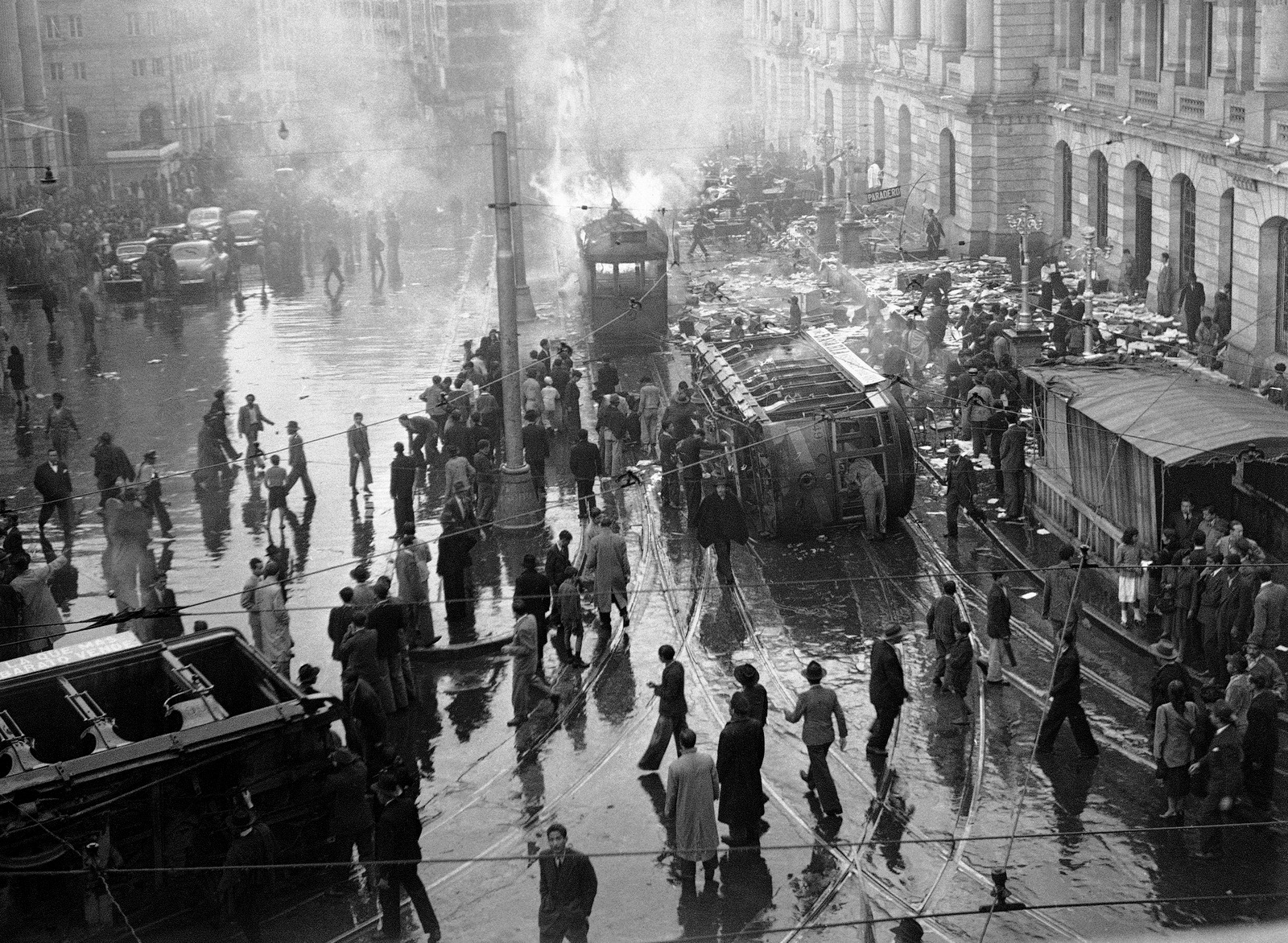 |
| A street car is overturned and burned during an uprising following the assassination of Jorge Eliecer Gaitan in Bogota, Columbia. The 1948 assassination of Gaitan sparked the political bloodletting known as “La Violencia,” or “The Violence.” (AP/E. L. Almen) |
Colombia’s
2016 peace agreement, for which outgoing center-right President Juan Manuel
Santos won a Nobel Prize, has been widely praised internationally. As a result
of the deal, Latin America’s oldest leftist guerrilla organization, the former
Revolutionary Armed Forces of Colombia (FARC), is now a legal electoral party,
the Revolutionary Alternative Forces of the Commons (also FARC).
But has
this peace truly managed to transform the roots of the country’s violence?
Since the FARC’s demobilization, hundreds of social leaders, including trade
unionists, campesino leaders, and coca farmers have been brutally
murdered. Demobilized FARC members have also been targeted, with around 56
people affiliated with the former guerrilla organization turned political party
having been killed since so-called “peace.”
this peace truly managed to transform the roots of the country’s violence?
Since the FARC’s demobilization, hundreds of social leaders, including trade
unionists, campesino leaders, and coca farmers have been brutally
murdered. Demobilized FARC members have also been targeted, with around 56
people affiliated with the former guerrilla organization turned political party
having been killed since so-called “peace.”
Paramilitary
violence in Colombia has deep roots. To learn more, MintPress spoke with
Professor Oliver Villar, author of Cocaine, Death Squads, and the War on
Terror: U.S. Imperialism and Class Struggle in Colombia, published by
Monthly Review Press.
violence in Colombia has deep roots. To learn more, MintPress spoke with
Professor Oliver Villar, author of Cocaine, Death Squads, and the War on
Terror: U.S. Imperialism and Class Struggle in Colombia, published by
Monthly Review Press.
Asked
about the origins of paramilitary violence in Colombia, Villar explained:
about the origins of paramilitary violence in Colombia, Villar explained:
Paramilitary
violence against leftists is part of Colombia’s long and deep history of class
warfare. We can go back to the Wars of Independence against Spain, but the
modern structures of paramilitary terror are traceable to La Violencia
(1948-58), when Conservatives set up death squads to assassinate their
political opponents the Liberals, as well as Communists who took up arms
against the State.”
It was this
context that led to numerous groups consisting of peasants, workers, students
and intellectuals — inspired to varying degrees by Marxism, the successful
Cuban revolution, and liberation theology — taking up arms against state and
paramilitary forces. Villar tells us:
context that led to numerous groups consisting of peasants, workers, students
and intellectuals — inspired to varying degrees by Marxism, the successful
Cuban revolution, and liberation theology — taking up arms against state and
paramilitary forces. Villar tells us:
This
violent history produced one of the most reactionary ruling classes in Latin
America but also one of the most effective and enduring forms of resistance
since the mid-20th century. As a result of this class war, was the creation of
a number of Marxist insurgencies throughout the 1960s; the most formidable were
the FARC-EP and ELN [National Liberation Army]. For over half a century, this
insurgency has existed in a virtual parallel universe, surviving the Cold War
and surviving the so-called ‘War on Terror.’”
Colombia’s
state was not acting without foreign support. As a resource-rich,
geopolitically strategic country, the United States has long seen the
“security” of Colombia as key to its own interests. Villar argues that the U.S.
has long been the “main sponsor” of state violence:
state was not acting without foreign support. As a resource-rich,
geopolitically strategic country, the United States has long seen the
“security” of Colombia as key to its own interests. Villar argues that the U.S.
has long been the “main sponsor” of state violence:
Since the
Kennedy administration identified the insurgency as being a greater threat than
the Vietcong, the U.S. has funded, trained and supported the Colombian State in
its war against leftists. In 2000, President Clinton introduced ‘Plan
Colombia,’ which was promoted as a ‘war on drugs’ but was in fact a
counterinsurgency program to eliminate the largest militant left-wing force –
the FARC.”
Plan Colombia
— implemented by the Clinton administration, but largely executed under the
Bush administration through the cooperation of far-right former Colombian
president, Alvaro Uribe Velez, who founded the Centro Democratico party — saw
over $10 billion flow into the South American nation.
— implemented by the Clinton administration, but largely executed under the
Bush administration through the cooperation of far-right former Colombian
president, Alvaro Uribe Velez, who founded the Centro Democratico party — saw
over $10 billion flow into the South American nation.
It is
often claimed by observers that
Colombia never experienced the periods of military dictatorship that swept
Latin America in the 1970s and 80s, but Villar strongly disagrees:
often claimed by observers that
Colombia never experienced the periods of military dictatorship that swept
Latin America in the 1970s and 80s, but Villar strongly disagrees:
Ex-president
Alvaro Uribe Velez is up there with America’s hard hitters: Videla, Pinochet,
Fujimori and so on.”
Alvaro Uribe Velez is up there with America’s hard hitters: Videla, Pinochet,
Fujimori and so on.”
This
hasn’t stopped Uribe from remaining one of the most influential and well-connected
Colombian politicians internationally. To this day, he regularly travels to the
U.S. for speaking
engagements at elite universities, and is praised by his friends in
the North for his supposed “success” in the “war on drugs.”
hasn’t stopped Uribe from remaining one of the most influential and well-connected
Colombian politicians internationally. To this day, he regularly travels to the
U.S. for speaking
engagements at elite universities, and is praised by his friends in
the North for his supposed “success” in the “war on drugs.”
Bolstered
by U.S.-derived money, Uribe’s terms in office oversaw a dramatic rise in
assassinations carried out by state forces. The United Nations even
acknowledges that, during his two terms, thousands were murdered by
military and police, with the crimes often covered up by disguising bodies as
FARC combatants, or blaming the killings on drug traffickers or guerrillas.
by U.S.-derived money, Uribe’s terms in office oversaw a dramatic rise in
assassinations carried out by state forces. The United Nations even
acknowledges that, during his two terms, thousands were murdered by
military and police, with the crimes often covered up by disguising bodies as
FARC combatants, or blaming the killings on drug traffickers or guerrillas.
WikiLeaks
documents have demonstrated a clear connection of Uribe’s “citizen
informant” and “convivir” security programs with illegal paramilitary groups.
Right-wing politician German Vargas Lleras recently claimed in a
Tweet that these programs should be revived.
documents have demonstrated a clear connection of Uribe’s “citizen
informant” and “convivir” security programs with illegal paramilitary groups.
Right-wing politician German Vargas Lleras recently claimed in a
Tweet that these programs should be revived.
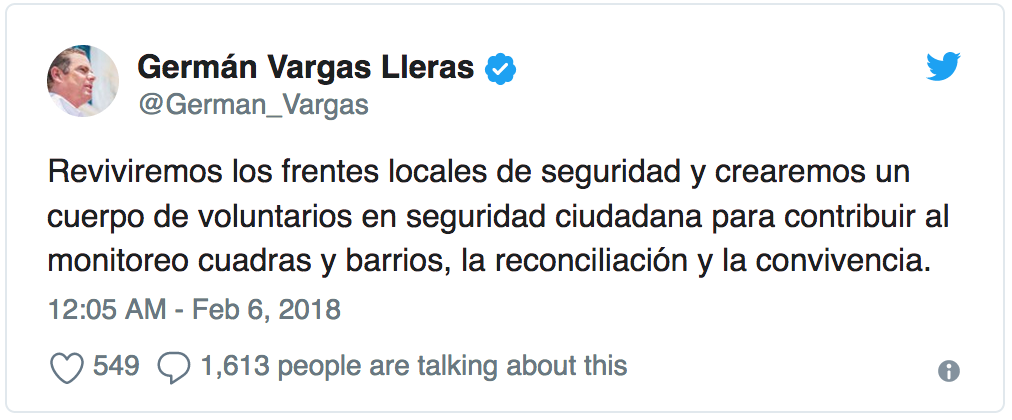
Translation
| We will revive the local security fronts and create a body of volunteers
in citizen security to contribute to the monitoring of blocks and
neighborhoods, reconciliation and coexistence.
| We will revive the local security fronts and create a body of volunteers
in citizen security to contribute to the monitoring of blocks and
neighborhoods, reconciliation and coexistence.
Uribe and
his family have faced and continue to face numerous investigations into paramilitary
ties, with accusations brought forward by left-leaning politicians
Gustavo Petro and Ivan Cepeda. In February, a court in Medellin ordered an
investigation into Uribe for his alleged role in paramilitary massacres as long
ago as the 1990s. Shortly after, Colombia’s Supreme Court called a further
investigation on suspicion that Uribe had falsified evidence and manipulated
witnesses in the cases against him.
his family have faced and continue to face numerous investigations into paramilitary
ties, with accusations brought forward by left-leaning politicians
Gustavo Petro and Ivan Cepeda. In February, a court in Medellin ordered an
investigation into Uribe for his alleged role in paramilitary massacres as long
ago as the 1990s. Shortly after, Colombia’s Supreme Court called a further
investigation on suspicion that Uribe had falsified evidence and manipulated
witnesses in the cases against him.
A
precarious “peace”
precarious “peace”
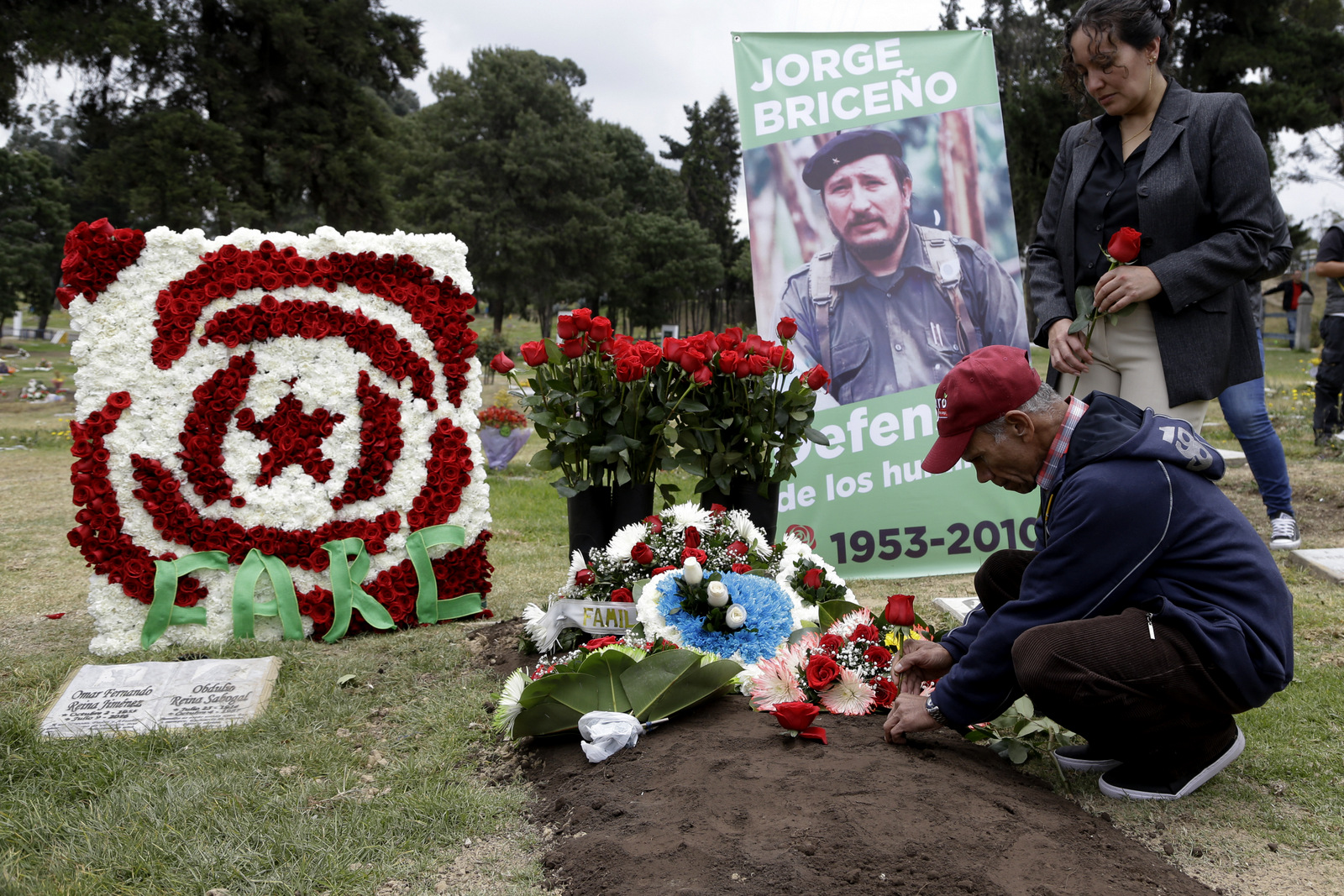 |
| A man places flowers on the grave of slain rebel leader Jorge Briceno, known as Mono Jojoy, during an homage of former members of the Revolutionary Armed Forces of Colombia, FARC, at a cemetery in southern Bogota, Colombia, Sept. 22, 2017. Briceno was killed by the Colombian Army on Sep. 22, 2010. (AP/Ricardo Mazalan) |
While the
FARC has held up its end of the peace deal, having successfully handed over
its weapons to the United Nations last year and registered as a
legal political party, ongoing violence shows that the social conditions that
cultivated armed struggle are still very much in place.
FARC has held up its end of the peace deal, having successfully handed over
its weapons to the United Nations last year and registered as a
legal political party, ongoing violence shows that the social conditions that
cultivated armed struggle are still very much in place.
Although
the state claims paramilitaries have demobilized, the “armed groups” continuing
to operate consist of largely the same actors as always, hailing from criminal
drug and illegal mining sectors. Gimena Sanchez — the Andes director at
Washington Office on Latin America (WOLA), who tracks U.S. policy in Colombia —
told MintPress News:
the state claims paramilitaries have demobilized, the “armed groups” continuing
to operate consist of largely the same actors as always, hailing from criminal
drug and illegal mining sectors. Gimena Sanchez — the Andes director at
Washington Office on Latin America (WOLA), who tracks U.S. policy in Colombia —
told MintPress News:
The
Colombian government tries to say it’s organized crime, then they called them
illegal armed groups … that tries to depoliticize their role. The reason that
Colombia doesn’t want them to be called paramilitaries is because that implies
collusion with the state.”
Sanchez,
who has spent time in the Choco region of Colombia, described how she had
observed how one of Colombia’s most notorious paramilitary groups of the Uribe
years, the United
Self-Defense Forces of Colombia (AUC — now-demobilized), evolved
from its “pre-incarnations,” through its eventual demobilization and
disintegration into various other “criminal groups.”
who has spent time in the Choco region of Colombia, described how she had
observed how one of Colombia’s most notorious paramilitary groups of the Uribe
years, the United
Self-Defense Forces of Colombia (AUC — now-demobilized), evolved
from its “pre-incarnations,” through its eventual demobilization and
disintegration into various other “criminal groups.”
“I can
say in that region (Choco), the names have changed, but they are the same
people,” Sanchez said.
say in that region (Choco), the names have changed, but they are the same
people,” Sanchez said.
Peace
with guerrillas had been tried before in Colombia, and ended in tragedy. When
the FARC’s previous electoral project, Marcha Patriótica, enjoyed significant
electoral success in 1986 with a land-reform platform, it provoked the ire of
Colombia’s landed interests and criminal networks. In the 1980s and 1990s,
paramilitaries massacred
thousands of Marcha Patriótica members, destroying the party and
reigniting war. The party wasn’t able to reconstitute as an entity distinct
from the FARC until 2013, a ghost of what it could have been, haunting all
subsequent efforts at peace.
with guerrillas had been tried before in Colombia, and ended in tragedy. When
the FARC’s previous electoral project, Marcha Patriótica, enjoyed significant
electoral success in 1986 with a land-reform platform, it provoked the ire of
Colombia’s landed interests and criminal networks. In the 1980s and 1990s,
paramilitaries massacred
thousands of Marcha Patriótica members, destroying the party and
reigniting war. The party wasn’t able to reconstitute as an entity distinct
from the FARC until 2013, a ghost of what it could have been, haunting all
subsequent efforts at peace.
Trading
guns for roses
guns for roses
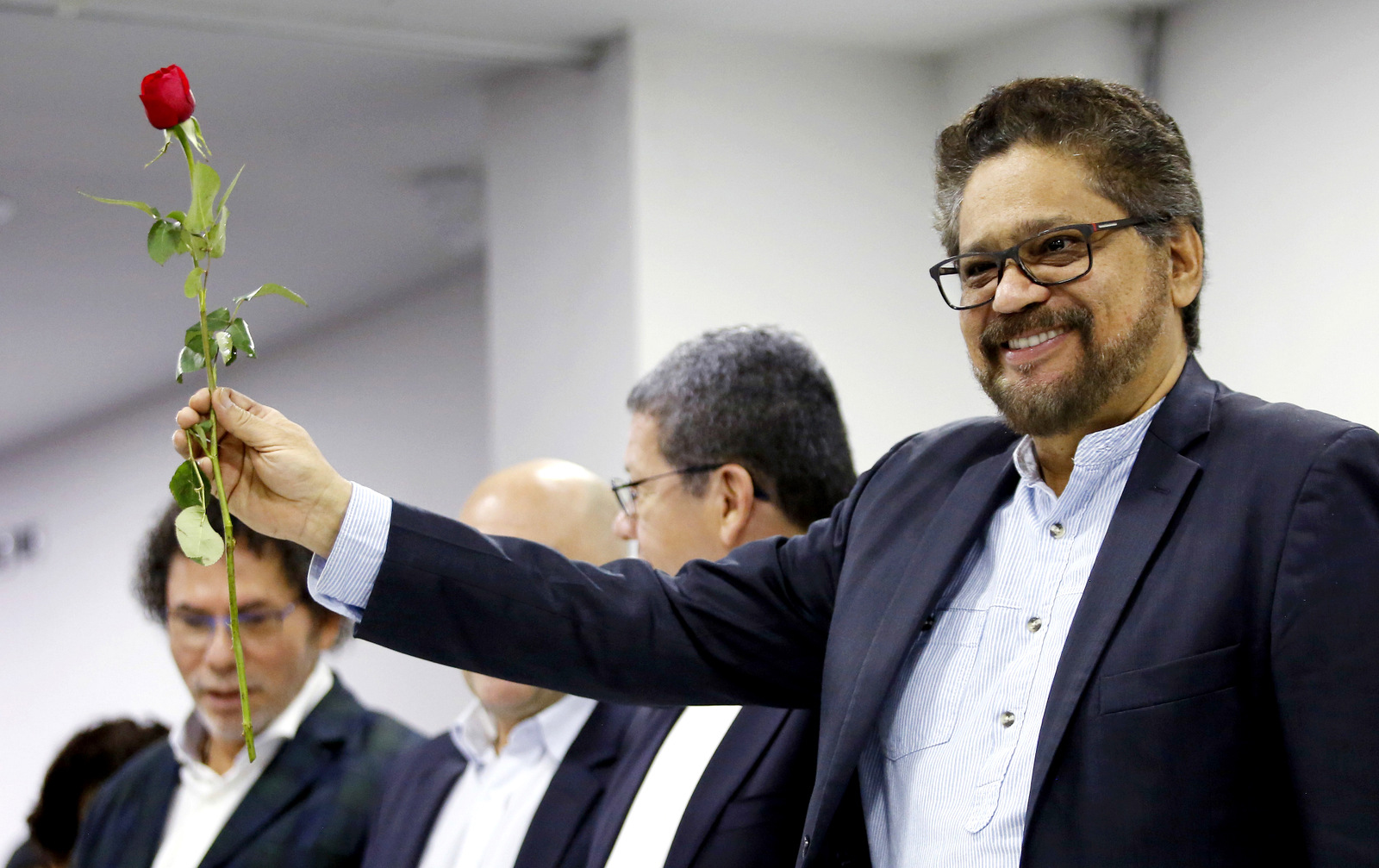 |
| Ivan Marquez holds a red rose, the symbol of the new political party Alternative Communal Revolutionary Forces, during a press conference in Bogota, Colombia, Sept. 1, 2017. (AP/Fernando Vergara) |
The
electoral road has not been easy for the FARC this time around. As an electoral
party with a new “rose” logo, they failed to win any more than the 10
legislative seats they were already guaranteed in the peace agreement. Ongoing
health problems, as well as near constant threats of violence, forced FARC
leader, Rodrigo “Timochenko” Londoño, to withdraw his
presidential campaign.
electoral road has not been easy for the FARC this time around. As an electoral
party with a new “rose” logo, they failed to win any more than the 10
legislative seats they were already guaranteed in the peace agreement. Ongoing
health problems, as well as near constant threats of violence, forced FARC
leader, Rodrigo “Timochenko” Londoño, to withdraw his
presidential campaign.
But while
mainstream media claim that the FARC’s difficulties as a legal party are a
“rejection” of the former guerrillas by the Colombian people, the FARC’s
leaders say that the lack of guarantees promised them in the peace deal has
made their electoral efforts to reach the Colombian people difficult to
impossible.
mainstream media claim that the FARC’s difficulties as a legal party are a
“rejection” of the former guerrillas by the Colombian people, the FARC’s
leaders say that the lack of guarantees promised them in the peace deal has
made their electoral efforts to reach the Colombian people difficult to
impossible.
Londoño
wrote in a March blog post:
wrote in a March blog post:
The party
of the commons won in spite of the obstacles and impediments, in spite of the
propaganda war, and very much in spite of the deaths among us, because we have
persisted in the political space won during decades of heroic struggle.”
International
and national opinion recognizes the threats, aggressions, and violent actions
organized against our candidates by representatives of the Centro Democratico.
No heart but mine resisted the suspension of our campaign more, with the
consequences it would have. But without the support of the State, without
electoral machines, without clientelism, without money, without corruption,
with the ‘media of mass destruction’ against us, facing dirty campaigns, but
armed with love, honesty, and conviction, of course we are victors.”
The FARC
— attempting to combat a negative perception among some in the cities
cultivated by years of media coverage portraying them as terrorists — have been
met with protests at their campaign rallies, which they say are provoked by
right-wing uribista groups.
— attempting to combat a negative perception among some in the cities
cultivated by years of media coverage portraying them as terrorists — have been
met with protests at their campaign rallies, which they say are provoked by
right-wing uribista groups.
Following
the legislative elections on March 11, the FARC released a
statement denouncing the fact that they were prohibited from opening
a bank account to access the campaign money to which they were legally
entitled.
the legislative elections on March 11, the FARC released a
statement denouncing the fact that they were prohibited from opening
a bank account to access the campaign money to which they were legally
entitled.
Reports of
vote fraud also emerged, something that has been claimed by many
political actors and observers.
vote fraud also emerged, something that has been claimed by many
political actors and observers.
Still,
the FARC is optimistic, and has said that “in spite of great difficulties
faced,” they will use their 10 senate seats to forge alliances with progressive
forces, secure the peace agreement, and work toward reforming an outdated and
broken electoral system. Newly elected FARC senator Pablo Catatumbo tweeted:
the FARC is optimistic, and has said that “in spite of great difficulties
faced,” they will use their 10 senate seats to forge alliances with progressive
forces, secure the peace agreement, and work toward reforming an outdated and
broken electoral system. Newly elected FARC senator Pablo Catatumbo tweeted:
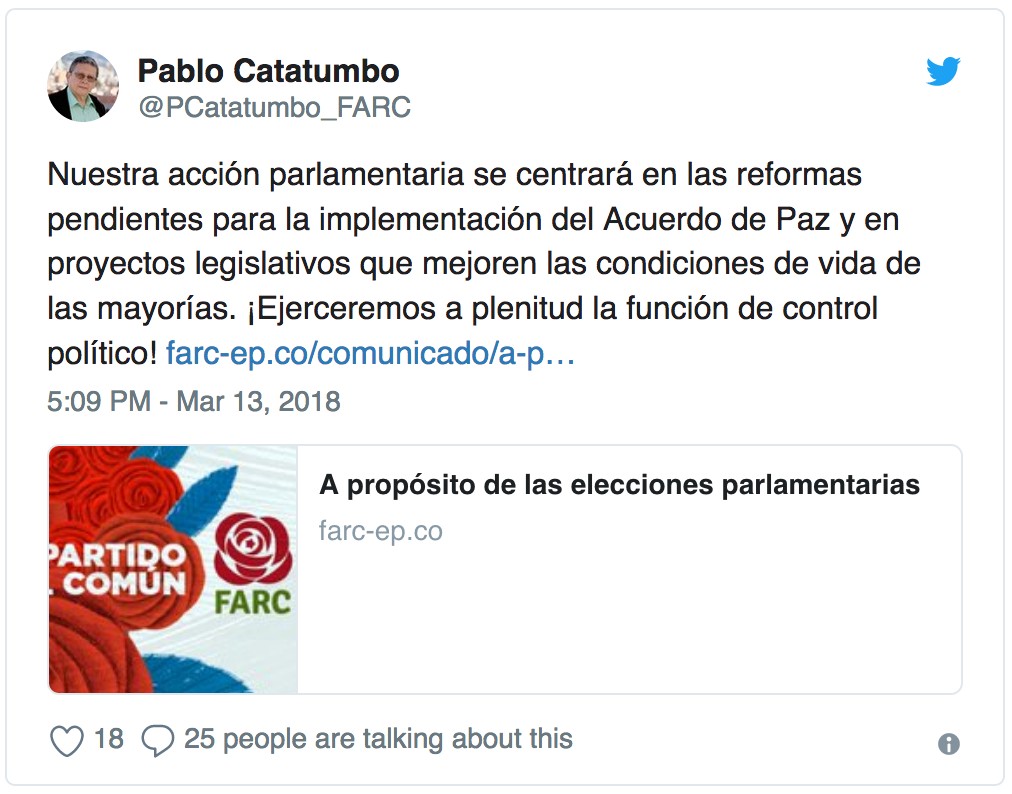
Translation
| Our parliamentary action will focus on the pending reforms for the
implementation of the Peace Agreement and on legislative projects that improve
the living conditions of the majorities.
| Our parliamentary action will focus on the pending reforms for the
implementation of the Peace Agreement and on legislative projects that improve
the living conditions of the majorities.
Most
significantly however, the FARC has
assured that their project will not limit itself to the electoral
realm:
significantly however, the FARC has
assured that their project will not limit itself to the electoral
realm:
With the
understanding that we don’t exclusively define ourselves as an electoral party,
we express our desire and firm intention to be with the social and popular
struggles in all parts of our country; we will be present in just causes of
protest, and the mobilization of the people of the common, and support the
dynamic constituents that generate social and popular movements.”
In spite
of their optimism, the withdrawal of Londoño from the campaign and their
difficulties in finding their footing electorally without the proper guarantees
from the State represent another major threat to the precarious peace. Many
observers argue that the ball is in the Santos government’s court to ensure
that their peace project doesn’t dissolve through a loss of trust.
of their optimism, the withdrawal of Londoño from the campaign and their
difficulties in finding their footing electorally without the proper guarantees
from the State represent another major threat to the precarious peace. Many
observers argue that the ball is in the Santos government’s court to ensure
that their peace project doesn’t dissolve through a loss of trust.
WOLA’s
Sanchez told MintPress:
Sanchez told MintPress:
If it
(the government) doesn’t implement the provisions related to land, truth,
justice and political plurality, as well as the programs designated for the
coca farmers, it won’t be too long before new armed groups confront the state.”
Uribe’s
return?
return?
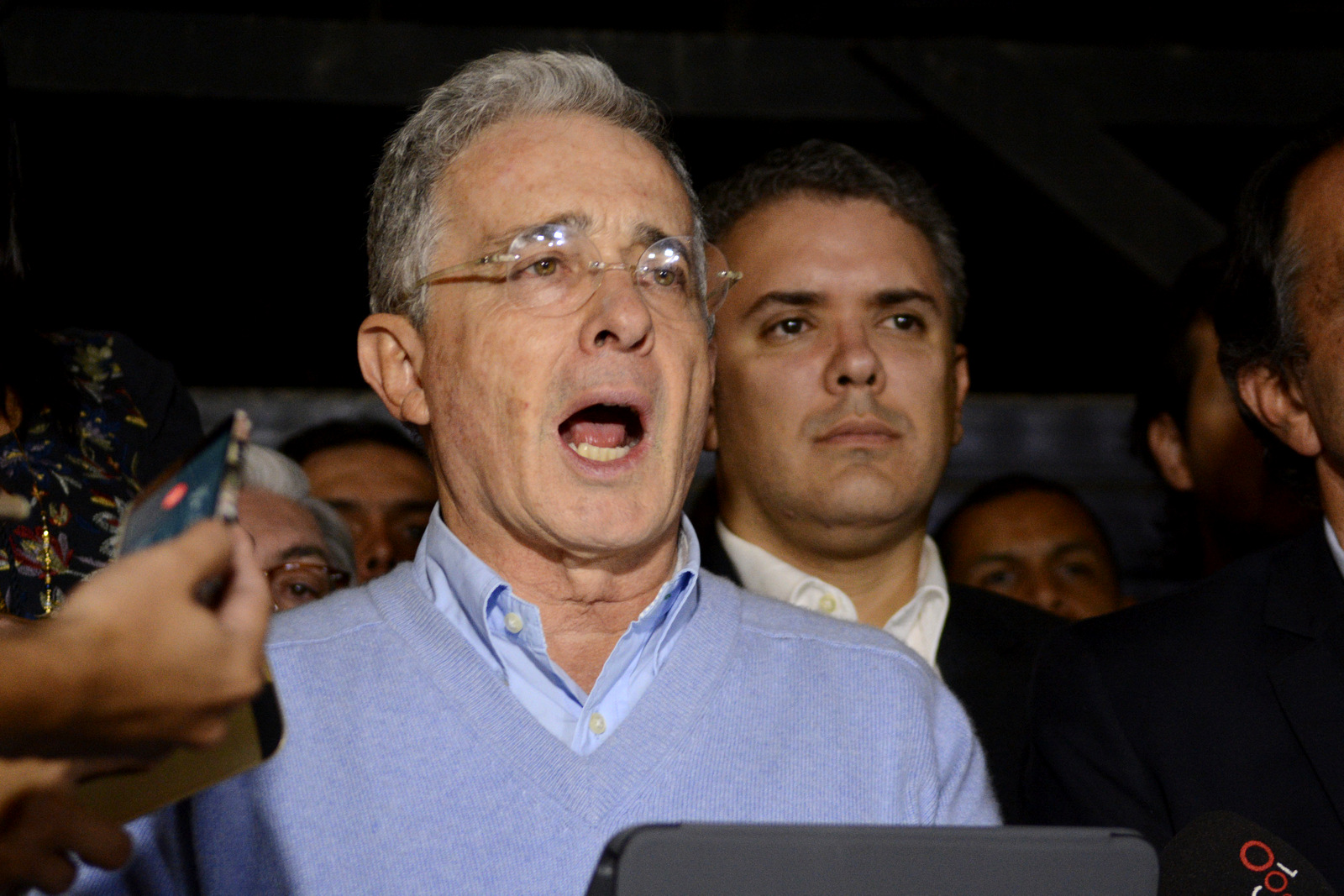 |
| Former President Alvaro Uribe, flanked by presidential candidate Ivan Duque, reads a statement at his house in Rionegro, Colombia, Oct. 2, 2016. (AP/Luis Benavides) |
When Juan
Manuel Santos, a former defense minister under Uribe, took the presidency, it
split Colombia’s oligarchy in two between those who wanted to try for peace
with the FARC, and those who, in Villar’s words, want to “finish what they
started.”
Manuel Santos, a former defense minister under Uribe, took the presidency, it
split Colombia’s oligarchy in two between those who wanted to try for peace
with the FARC, and those who, in Villar’s words, want to “finish what they
started.”
The uribista
camp has remained a strong political force, opposing a
peace deal from the beginning, while Santos and his allies who
ranged across the political spectrum negotiated the eventual disarmament of the
FARC in exchange for immunity and legal political participation.
camp has remained a strong political force, opposing a
peace deal from the beginning, while Santos and his allies who
ranged across the political spectrum negotiated the eventual disarmament of the
FARC in exchange for immunity and legal political participation.
Under the
Obama administration, the U.S. Congress promoted the peace agreement under
bipartisan consensus, and renamed the Plan Colombia program “Paz Colombia.”
Obama administration, the U.S. Congress promoted the peace agreement under
bipartisan consensus, and renamed the Plan Colombia program “Paz Colombia.”
Villar
argues:
argues:
The
government of Juan Manuel Santos represents the modern bourgeoisie, the agro-mineral
and financial classes, urban and cosmopolitan, closely intertwined with the
interest of U.S. finance capital, which was strongly supported by Obama. Uribe
and the “extreme right” represent the narcobourgeoisie who fought the war with
paramilitary death squads.”
The
extreme-right “narcobourgeoisie” forces behind Uribe could see a return in May
27 elections, should the Centro Democratico’s candidate, Ivan Duque, assume the
presidency.
extreme-right “narcobourgeoisie” forces behind Uribe could see a return in May
27 elections, should the Centro Democratico’s candidate, Ivan Duque, assume the
presidency.
Camilo
Gonzalez, the director of the Institute for Studies of Development and Peace
(Indepaz), said in a statement
recently:
Gonzalez, the director of the Institute for Studies of Development and Peace
(Indepaz), said in a statement
recently:
With the
tie in the composition of the Congress of the Republic, the fate of the peace
accord implementation depends on the results of the presidential elections.”
Presidential
candidate Ivan Duque, who is neck and neck with Gustavo Petro, has opposed the
peace process every step of the way, and refuses to acknowledge the
FARC as a legitimate political party, saying he “doesn’t like giving prizes to
criminals.”
candidate Ivan Duque, who is neck and neck with Gustavo Petro, has opposed the
peace process every step of the way, and refuses to acknowledge the
FARC as a legitimate political party, saying he “doesn’t like giving prizes to
criminals.”
In an interview
with Colombian paper El Pais, Duque said:
with Colombian paper El Pais, Duque said:
There are
legal issues involving the impunity in this country for FARC criminals; our
agenda includes dealing with criminal drug gangs, with the rise in illicit
crops, and with the ELN guerrilla. For that, the state will need a great
capacity for offensive and deterrence action.”
A return
to uribismo could also be reflective of a shift in the United States’ attitude
under the Trump administration toward one that desires a yet more militarized
Colombia to regionally counter Venezuela.
to uribismo could also be reflective of a shift in the United States’ attitude
under the Trump administration toward one that desires a yet more militarized
Colombia to regionally counter Venezuela.
According
to WOLA’s Sanchez, although the U.S. Senate is still largely supportive of
peace and the Santos approach, the Trump administration has focused on two
things: the drug war, and Colombia’s socialist neighbor Venezuela. Trump may be
taking more cues from Senator Marco Rubio (R-FL), who is close with Uribe.
to WOLA’s Sanchez, although the U.S. Senate is still largely supportive of
peace and the Santos approach, the Trump administration has focused on two
things: the drug war, and Colombia’s socialist neighbor Venezuela. Trump may be
taking more cues from Senator Marco Rubio (R-FL), who is close with Uribe.
Rubio has
recently been highly critical of Trump’s pick for Colombian ambassador, Joseph
Macmanus — pushing for someone more hardline, who could enforce “America First”
in Colombia — and criticized him during a Senate confirmation
hearing on March 7. It remains unclear whether or not, at Rubio’s
urging, Macmanus will join the ranks of the fired in Trump’s administration.
Sanchez concluded:
recently been highly critical of Trump’s pick for Colombian ambassador, Joseph
Macmanus — pushing for someone more hardline, who could enforce “America First”
in Colombia — and criticized him during a Senate confirmation
hearing on March 7. It remains unclear whether or not, at Rubio’s
urging, Macmanus will join the ranks of the fired in Trump’s administration.
Sanchez concluded:
Marco
Rubio said in the hearing we have to protect Colombia from the threat of
Venezuela. I think we’ll be hearing a lot more of this, that Colombia is a
barrier for Venezuela. If history repeats itself, with another Uribe, you could
see more tensions.”
Colombia
regional positioning makes it geopolitically an important piece in the “America
First” agenda. Villar argues:
regional positioning makes it geopolitically an important piece in the “America
First” agenda. Villar argues:
Donald
Trump has declared that the United States is facing growing competition from
Russia and China, two great-power rivals which he says ‘seek to challenge U.S.
influence, values and wealth.’ The Colombian question is vital to U.S.
domination and, as Trump knows, ‘America is in the game,’ one that he thinks
‘America is going to win.’ But so is America’s main competitor in the region,
China.”
With a
campaign built on fear-mongering, that “castrochavismo,”
an amalgam of Cuban and Venezuelan revolutionary leaders Fidel Castro and Hugo
Chavez, will “destroy” Colombia, and a population apathetic toward the
country’s politics (over 62 percent of Colombians abstained in
2016’s referendum on peace), Duque stands a chance at winning,
putting the Santos peace deal at risk.
campaign built on fear-mongering, that “castrochavismo,”
an amalgam of Cuban and Venezuelan revolutionary leaders Fidel Castro and Hugo
Chavez, will “destroy” Colombia, and a population apathetic toward the
country’s politics (over 62 percent of Colombians abstained in
2016’s referendum on peace), Duque stands a chance at winning,
putting the Santos peace deal at risk.
Perhaps
only one thing is certain in Colombian politics at the moment: for Colombia’s
poorest, peace is likely to remain only a fantasy of the wealthy while an
entrenched oligarchy continues dismantling progressive aspirations, physically
and ideologically, one century after those same reactionary forces massacred
thousands so that those in the North could eat their cheap bananas.
only one thing is certain in Colombian politics at the moment: for Colombia’s
poorest, peace is likely to remain only a fantasy of the wealthy while an
entrenched oligarchy continues dismantling progressive aspirations, physically
and ideologically, one century after those same reactionary forces massacred
thousands so that those in the North could eat their cheap bananas.


